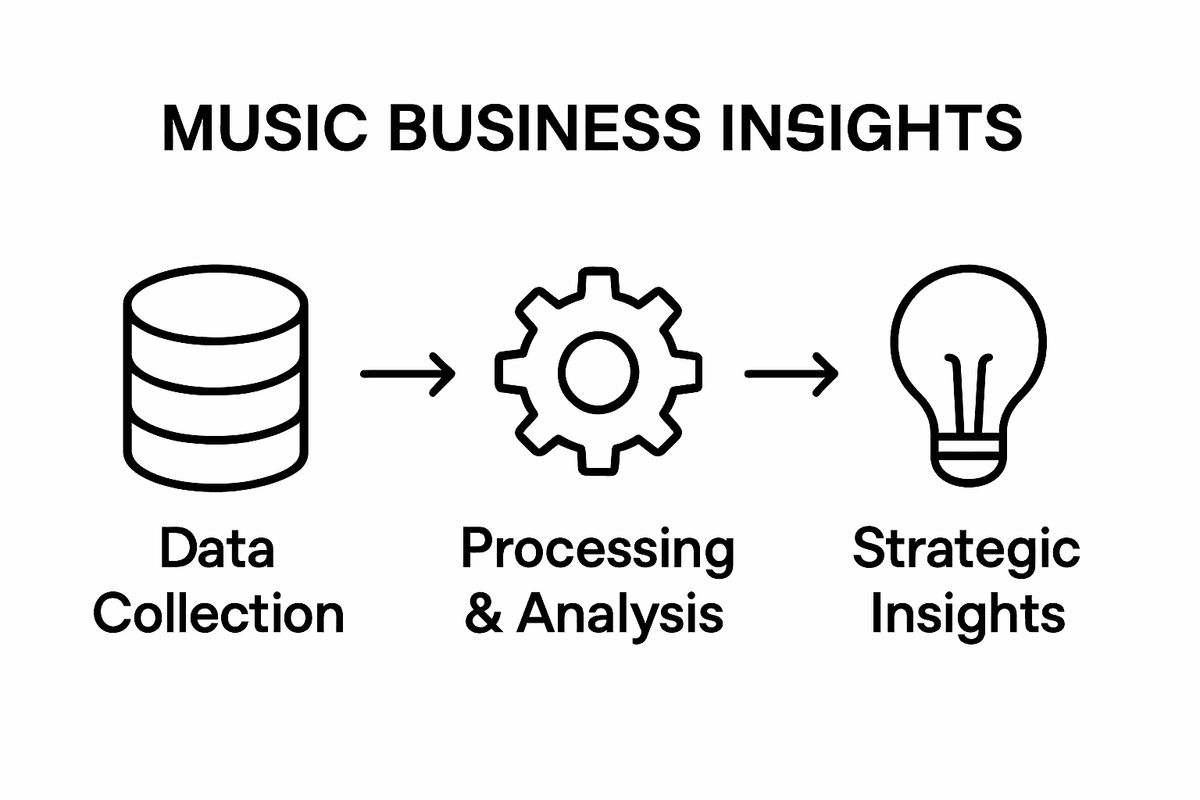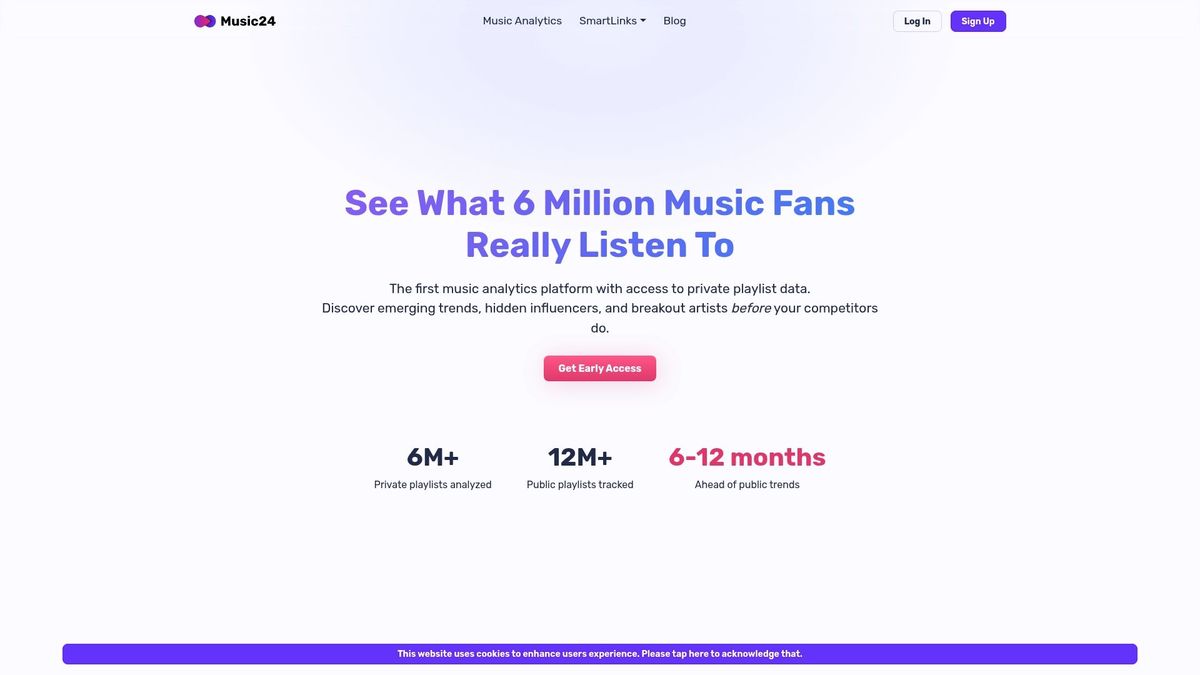Every big move in the music industry is driven by data now. Streaming platforms generate billions of new data points every single day, tracking what songs people love, share, and repeat. Most people assume this ocean of numbers is just for the tech teams crunching stats in the background. Turns out, music analytics workflow is the secret engine shaping which artists get discovered, which songs rise to the top, and how every next global hit is predicted before it goes viral.
Table of Contents
- What Is Music Analytics Workflow?
- Why Music Analytics Workflow Matters In The Industry
- How Music Analytics Workflow Functions
- Key Concepts In Music Analytics Workflow
- Real-World Applications Of Music Analytics Workflow
Quick Summary
| Takeaway | Explanation |
|---|---|
| Data collection is essential for music analytics. | Gathering data from sources like streaming and social media enables insights into listener behavior. |
| Advanced analysis predicts trends and preferences. | Utilizing statistical models and machine learning helps identify emerging music trends and audience interests. |
| Targeted strategies drive marketing success. | Music analytics informs personalized promotional campaigns and optimizes marketing efforts based on audience demographics. |
| Artist development relies on data-driven insights. | Data helps identify potential breakthrough artists and informs career strategies for effective growth. |
| Analytics provide competitive differentiation. | Organizations leveraging data can uncover niche audiences and craft unique marketing approaches in a crowded industry. |
What is Music Analytics Workflow?
A music analytics workflow represents a structured, systematic approach to collecting, processing, analyzing, and interpreting music-related data to drive strategic decision making in the music industry. This comprehensive process transforms raw musical data into actionable insights that enable professionals to understand listener behaviors, track performance metrics, and predict emerging trends.
Core Components of Music Analytics
Music analytics workflow encompasses several interconnected elements that work together to generate meaningful intelligence. These core components include:

- Data Collection: Gathering information from multiple sources such as streaming platforms, social media, playlist data, and listener engagement metrics
- Data Processing: Cleaning, organizing, and standardizing collected data to ensure accuracy and reliability
- Advanced Analysis: Applying statistical models and machine learning techniques to extract deeper insights and patterns
The primary goal of this workflow is to provide music industry professionals with a predictive and comprehensive understanding of music consumption, artist performance, and listener preferences. Our guide to music data interpretation offers deeper insights into these analytical techniques.
Strategic Applications
Professionals across various music industry sectors leverage music analytics workflows to make informed decisions. Record labels use these insights to identify emerging talent, artist managers track audience growth and engagement, and marketers develop targeted promotional strategies based on data driven recommendations.
By systematically analyzing complex datasets, music analytics workflows transform raw information into strategic intelligence, enabling more precise and effective decision making in an increasingly competitive musical landscape.
Below is a table summarizing the core components of the music analytics workflow and their main functions to clarify each stage for readers.
| Component | Description |
|---|---|
| Data Collection | Gathering information from multiple sources, including streaming platforms and social media |
| Data Processing | Cleaning, organizing, and standardizing data to ensure accuracy and reliability |
| Advanced Analysis | Applying statistical and machine learning techniques to extract patterns and insights |
| Interpretation | Translating analytical findings into actionable insights and strategic recommendations |
| Strategy Implementation | Using insights to guide artist development, marketing, and audience engagement decisions |
Understanding and implementing a robust music analytics workflow can provide significant competitive advantages for music industry professionals seeking to stay ahead of evolving trends and listener preferences.
Why Music Analytics Workflow Matters in the Industry
In the rapidly evolving digital music landscape, a robust music analytics workflow has become more than a competitive advantage—it is now an essential strategic necessity for survival and success. By transforming complex data into actionable intelligence, music industry professionals can make informed decisions that drive growth, innovation, and strategic positioning.
Economic and Strategic Implications
Music analytics workflows provide critical insights that directly impact economic outcomes. Precise data interpretation enables organizations to optimize resource allocation, identify emerging market opportunities, and minimize financial risks. How to detect music trends early can help professionals stay ahead of market shifts.
Key economic benefits include:
- Identifying potential breakthrough artists before they become mainstream
- Understanding audience demographics and listening behaviors
- Predicting genre and style trends with higher accuracy
- Developing targeted marketing strategies based on empirical data
Competitive Differentiation
In an industry saturated with content and competing for listener attention, music analytics workflows offer a significant competitive edge. By leveraging advanced data analysis techniques, organizations can:
- Uncover niche audience segments
- Develop more personalized artist development strategies
- Create data driven promotional campaigns
- Optimize playlist and streaming platform performance
According to research from Berklee College of Music, the unprecedented growth of music streaming services has generated massive amounts of usage data. Organizations that effectively analyze this data can audit digital artist presence, build performance benchmarks, and develop actionable insights that transform raw information into strategic advantage.

Ultimately, a sophisticated music analytics workflow is not just about collecting data—it is about translating complex information into meaningful strategies that drive artistic innovation, audience engagement, and business success in the contemporary music ecosystem.
How Music Analytics Workflow Functions
Music analytics workflow operates as a sophisticated, multi-stage process that transforms raw musical data into strategic insights through systematic and advanced technological approaches. This intricate system leverages cutting edge computational techniques to extract meaningful information from complex datasets across multiple music ecosystem platforms.
Data Acquisition and Integration
The initial phase of the music analytics workflow focuses on comprehensive data collection from diverse sources. Music professionals gather information from streaming platforms, social media channels, playlist repositories, and listener engagement metrics. Learn more about playlist analytics strategies to understand data collection nuances.
Key data sources include:
- Streaming platform usage statistics
- Social media engagement metrics
- Listener demographic information
- Geographic streaming patterns
- Historical performance data
Advanced Processing and Analysis
Once data is collected, sophisticated algorithms and machine learning techniques process and analyze the information. Computational models transform raw data into actionable insights by:
- Identifying emerging music trends
- Predicting listener preferences
- Analyzing artist performance metrics
- Detecting potential breakthrough artists
- Mapping genre evolution patterns
According to research exploring multimodal music information processing, advanced computational approaches enable music professionals to extract complex insights beyond traditional analytical methods.
The final stage involves translating processed data into strategic recommendations. Music industry professionals utilize these insights to make informed decisions about artist development, marketing strategies, and audience engagement, effectively converting complex digital information into tangible business opportunities.
Key Concepts in Music Analytics Workflow
Understanding the fundamental principles of music analytics workflow requires a comprehensive exploration of its core conceptual frameworks. These foundational elements provide the theoretical and practical scaffolding that enables music industry professionals to transform complex data into meaningful strategic insights.
Fundamental Data Dimensions
Music analytics workflow operates across multiple interconnected data dimensions that capture the nuanced dynamics of musical consumption and creation. Quantitative and qualitative data points work in concert to provide a holistic understanding of musical trends and audience behaviors.
Key data dimensions include:
- Listener Engagement Metrics: Streaming duration, repeat listens, playlist additions
- Geographical Performance: Regional streaming patterns, cultural music preferences
- Demographic Segmentation: Age group listening habits, genre preferences by demographic
- Temporal Trends: Seasonal music consumption patterns, genre evolution cycles
Advanced Analytical Frameworks
The sophisticated nature of music analytics workflow demands robust analytical frameworks that go beyond traditional data interpretation methods. Our guide to music data interpretation provides deeper insights into these complex methodologies.
Critical analytical approaches encompass:
- Machine learning predictive modeling
- Network analysis of musical interconnections
- Sentiment and emotional response tracking
- Cross platform performance benchmarking
According to research from The Hong Kong Polytechnic University, successful music analytics workflows bridge quantitative insights with creative strategic thinking, transforming raw data into actionable intelligence that drives music industry innovation.
By integrating advanced computational techniques with nuanced understanding of musical ecosystems, music analytics workflow emerges as a powerful tool for decoding the complex, dynamic landscape of contemporary music consumption and creation.
This table outlines fundamental data dimensions in music analytics and what each measures, offering readers a clear overview of essential analytical categories.
| Data Dimension | What It Measures |
|---|---|
| Listener Engagement Metrics | Duration streamed, repeat listens, playlist adds |
| Geographical Performance | Regional streaming patterns, cultural music preferences |
| Demographic Segmentation | Age-based listening, genre popularity by audience segment |
| Temporal Trends | Seasonal listening patterns, changes in genre or style over time |
| Artist Performance Metrics | Growth in audience, engagement across platforms |
| Sentiment Analysis | Listener emotions and responses to tracks/releases |
Real-World Applications of Music Analytics Workflow
Music analytics workflows transcend theoretical frameworks, delivering tangible value across multiple sectors of the music industry. By translating complex data into actionable strategies, these sophisticated analytical approaches enable professionals to make informed decisions that drive innovation, creativity, and strategic growth.
Artist Discovery and Development
Music analytics workflows revolutionize talent identification and artist development processes. Record labels and talent management teams leverage data driven insights to discover emerging artists, understand their potential market appeal, and design targeted career development strategies.
Key applications in artist development include:
- Identifying artists with viral potential
- Tracking audience growth and engagement metrics
- Predicting genre crossover opportunities
- Analyzing listener demographic compatibility
- Mapping potential touring and collaboration strategies
Marketing and Promotional Strategies
Advertisers and marketing professionals utilize music analytics workflows to craft precision targeted campaigns that maximize audience reach and engagement. Explore our playlist analytics examples to understand advanced marketing techniques.
Critical marketing applications encompass:
- Designing demographically targeted promotional campaigns
- Identifying optimal playlist placement strategies
- Understanding listener sentiment and emotional responses
- Tracking real time audience reaction to new releases
- Developing personalized recommendation algorithms
According to research from NYU's Music and Audio Research Laboratory, advanced music analytics techniques enable sophisticated machine listening approaches that transform how professionals understand and interact with musical data.
By integrating computational intelligence with creative understanding, music analytics workflows provide a powerful lens through which industry professionals can decode complex musical ecosystems, transforming raw data into strategic opportunities that drive artistic and commercial success.
Gain an Unmatched Edge with Predictive Music Analytics
Are you tired of missing breakthrough artists or acting too late on emerging music trends? The article highlighted how relying only on traditional, public-facing metrics can prevent you from making truly data-driven decisions. Without access to authentic music discovery patterns and private playlist behaviors, industry professionals often struggle with slow response times, inaccurate audience targeting, and missed marketing opportunities.
Music24 offers a transformative solution. Our platform accesses millions of anonymized private playlists to reveal early signals on rising artists, influential curators, and real-time music discovery far ahead of public charts or social trends. With unique insight into genre blending, geographic micro-trends, and private playlist creator influence, you get deeper clarity and a reliable early advantage for your A&R, marketing, or artist management strategies. Want real examples of how strategic playlist analysis changes the game? Check out our playlist analytics examples or learn how to detect music trends early for a glimpse of what you can achieve.

Ready to move beyond surface-level stats and tap into the real heartbeat of music discovery? Start leveraging the predictive power of Music24 today so you can identify talent, trends, and audience shifts before anyone else. Experience the future of music analytics now.
Frequently Asked Questions
What is a music analytics workflow?
A music analytics workflow is a structured process used to collect, process, analyze, and interpret music-related data, transforming it into actionable insights for strategic decision-making in the music industry.
Why is music analytics workflow important in the music industry?
Music analytics workflows are essential for making informed decisions that drive growth, innovation, and strategic positioning within a competitive market by interpreting complex data into valuable intelligence.
How does data collection work in a music analytics workflow?
Data collection involves gathering information from various sources, including streaming platforms, social media, playlist data, and listener engagement metrics, to create a comprehensive dataset for analysis.
What are some applications of music analytics workflows in marketing strategies?
Music analytics workflows help marketers design targeted promotional campaigns, identify optimal playlist placements, understand listener sentiment, and develop personalized recommendation algorithms to maximize audience engagement.
Recommended
- Understanding the Guide to Music Data Interpretation - Blog - Music24.com
- 7 Playlist Analytics Examples to Boost Your Strategy - Blog - Music24.com
- How to Detect Music Trends Early and Stay Ahead in 2025 - Blog - Music24.com
- How to Leverage Private Playlist Data for Artist Growth - Blog - Music24.com
- How to Use Blog Analytics for Growth and Success


